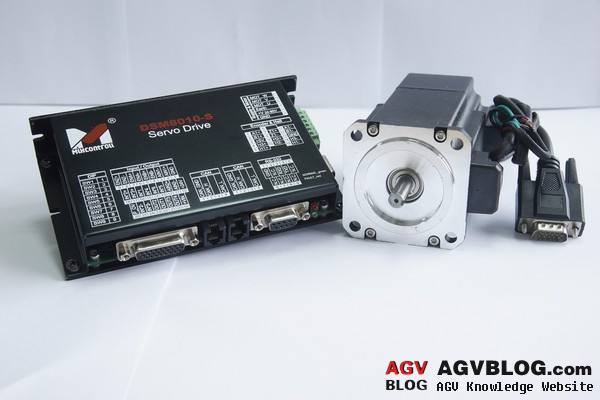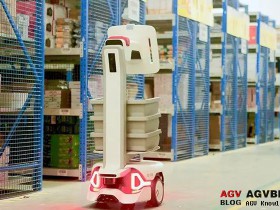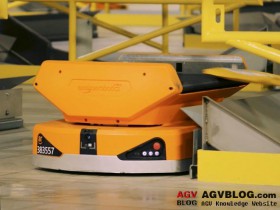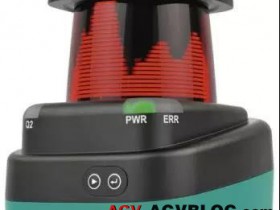The body of the AGV car is composed of the frame and corresponding mechanical and electrical components such as gearbox, motor, drive wheel, etc. It is the basic part of AGV. The servo motor is directly connected to the driving wheel, and the servo motor directly transmits the power to the driving wheel, thereby driving the entire automated engineering machinery or AGV trolley forward. The following is an analysis of the top ten faults of servo motors.

Three-phase AC servo motors are widely used, but after long-term operation, various failures will occur. Judging the cause of the fault in time and handling it accordingly is an important task to prevent the fault from expanding and to ensure the normal operation of the equipment.
The main faults and analysis of the servo motor:
1. The noise is abnormal when the motor is running
1. Cause of failure
① The bearing is worn or there are foreign objects such as sand in the oil;
② Loose rotor core;
③The bearing is short of oil;
④ The power supply voltage is too high or unbalanced.
2. Troubleshooting
①Replace the bearing or clean the bearing;
②Repair the rotor core;
③ Come on;
④ Check and adjust the power supply voltage.
Second, the motor encoder alarm
1. Cause of failure
① Wiring error;
② Electromagnetic interference;
③ The encoder hardware damage caused by mechanical vibration;
④ Pollution caused by the on-site environment;
2. Troubleshooting
①Check the wiring and eliminate the error;
②Check whether the shield is in place, check whether the wiring is reasonable and resolved, and add filters to improve if necessary;
③ Check the mechanical structure and improve it;
④ Check whether the inside of the encoder is contaminated or corroded (dust, oil, etc.) and strengthen protection;
3. Installation and wiring standards
① Try to use original cables;
② Separate the cable to keep it away from contaminated wiring as much as possible, especially high-pollution wiring;
③ Always use the internal power supply whenever possible. If you use a switching power supply, you should use a filter to ensure that the power supply reaches a clean level;
④ Always ground the common terminal;
⑤ Keep the encoder shell insulated from the machine structure and connect to the cable shielding layer;
⑥If the encoder cannot be insulated, the cable shield can be connected to the ground (or dedicated terminal) on the encoder housing and the driver frame.
3. The motor cannot rotate after power on, but there is no abnormal noise, no smell and smoke
1. Cause of failure
① The power supply is not connected (at least two phases are not connected);
② Fuse blown (at least two-phase blown);
③ The overcurrent relay is adjusted too small;
④The wiring of control equipment is wrong.
2. Troubleshooting
① Check whether there is a breakpoint at the power circuit switch, fuse and junction box, repair;
② Check the fuse type, the reason for the fuse, and replace with a new fuse;
③ Adjust the setting value of the relay to cooperate with the motor;
④ Correct the wiring.
Fourth, the motor shaft is broken
1. Cause of failure
① Unreasonable mechanical design leads to excessive radial load;
② The load end is stuck or severe transient overload;
③The motor and reducer are not concentric when assembled;
2. Troubleshooting
①Check the maximum radial load force that can be withstood in the motor sample and improve the mechanical design;
② Check the operation of the load end, confirm the actual process requirements and improve it;
③Check whether the load operation is stable and whether there is vibration, and improve the mechanical assembly accuracy.
Fifth, the no-load current of the motor is unbalanced, and the three-phase phase difference is large
1. Cause of failure
① The winding ends are connected wrongly;
② Unbalanced power supply voltage;
③ The winding has short-circuit between turns and reverse connection of the coil.
2. Troubleshooting
①Check and correct;
②Measure the power supply voltage and try to eliminate the unbalance;
③ Eliminate winding faults.
Sixth, the motor does not turn and there is a buzzing sound after power on
1. Cause of failure
①The rotor winding is broken (one phase is broken) or the power supply is lost in one phase;
② The beginning and end of the winding lead wire are connected wrong or the winding is connected internally;
③ The power circuit contacts are loose, and the contact resistance is large;
④ The motor load is too large or the rotor is stuck;
⑤ The power supply voltage is too low;
⑥ The assembly of the small motor is too tight or the grease in the bearing is too hard;
⑦ The bearing is stuck.
2. Troubleshooting
① Identify the breakpoint and fix it;
② Check the polarity of the winding; determine whether the winding end is correct;
③ Tighten the loose connection screws, use a multimeter to determine whether the connectors are falsely connected, and repair them;
④ Reduce load or detect and eliminate mechanical failure;
⑤ Check whether the specified surface connection is mistakenly connected; whether the voltage drop is too large due to the power wire being too thin, and correct it;
⑥Reassembly makes it flexible; replace qualified grease;
⑦Repair the bearing.
7. It is difficult to start the motor at rated load.
The motor speed is more than the rated speed
1. Cause of failure
① The power supply voltage is too low;
②The motor of the face connection method is wrongly connected;
③The rotor is welded or broken;
④The local coils of the rotor are wrongly connected or reversed, and too many turns are added when repairing the motor winding.
⑤ The motor is overloaded.
2. Troubleshooting
①Measure the power supply voltage and try to improve;
② Correct the connection;
③ Check the welding and breakpoints and repair;
④ Correct the wrong connection;
⑤ Restore the correct number of turns;
⑥ Reduced load.
8. The motor overheats or even smokes
1. Cause of failure
① The power supply voltage is too high;
②The power supply voltage is too low, the motor is running with a rated load, and the current exceeds the ambassador winding heating
③ When repairing and removing the winding, the thermal dismantling method is improper and burns the iron core;
④ The motor is overloaded or frequently started;
⑤ The motor lacks phase and runs in two phases;
⑥ After rewinding, it is determined that the winding is not fully dipped in paint;
⑦The ambient temperature is high, the surface of the motor is much dirt, or the air duct is blocked.
2. Troubleshooting
① Reduce the power supply voltage (such as adjusting the tap of the power supply transformer);
② Increase the power supply voltage or change the thick power supply wire;
③Repair the iron core and eliminate the fault;
④ Reduce the load; control the start according to the prescribed times;
⑤Resume three-phase operation;
⑥Adopt secondary dipping and vacuum dipping process;
⑦ Clean the motor, improve the ambient temperature, and adopt cooling measures.
Nine, the motor vibration is large during operation
1. Cause of failure
① The bearing clearance is too large due to wear;
② The air gap is uneven;
③The rotor is unbalanced;
④Bending shaft;
⑤ Coupling (belt pulley) coaxiality is too low.
2. Troubleshooting
①Repair the bearing and replace it if necessary;
②Adjust the air gap to make it even;
③ Correct the rotor dynamic balance;
④Straighten the shaft;
⑤ Recalibrate to make it meet the regulations.
Ten, bearing overheating
1. Cause of failure
① Too much or too little grease;
②The oil is not good and contains impurities;
③The bearing is not properly matched with the journal or the end cover (too loose or too tight);
④The bearing bore is eccentric and rubs against the shaft;
⑤ The motor end cover or bearing cover is not installed flat;
⑥ The coupling between the motor and the load is not corrected, or the belt is too tight;
⑦The bearing gap is too large or too small;
⑧ The motor shaft is bent.
2. Troubleshooting
① Add grease as required (1 / 3-2 / 3 of the volume);
② Replace the clean grease;
③ Too loose can be repaired with adhesive, too tight should be car, grinding the journal or the inner hole of the end cover to make it suitable;
④Repair the bearing cover and eliminate the rubbing points; for more exciting content, please pay attention to the training of micro signal technology;
⑤ Reassembly;
⑥ Recalibrate and adjust the belt tension;
⑦Replace new bearings;
⑧ Correct the motor shaft or replace the rotor.




